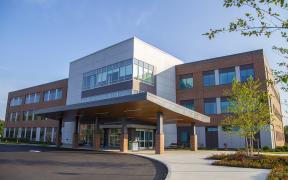The aorta is the large artery that brings blood to the head, neck and lower body. Such a vital artery deserves the utmost care. Our multi-disciplinary team is dedicated to achieving the best possible outcomes for patients dealing with aortopathies.
What is aortopathy?
Conditions called aortopathies can lead to changes in the tissue of arteries, including the aorta, which can lead to the enlargement (or dilation) of the aorta. When the aorta becomes dilated significantly, it can be life-threatening. Aortopathy can sometimes run in families, but can also happen spontaneously. Some aortopathic conditions can be associated with a specific genetic mutation.
Provider Referrals
Diagnosis and Treatment
Conditions include:
- Marfan syndrome affects multiple systems in the body—including the eyes, joints and aorta. It can lead to lens dislocation in the eye, scoliosis, heart valve dysfunction and aortic dilation.
- Vascular Ehlers-Danlos can also affect multiple systems—including skin, joints and blood vessels. It can lead to stretchy, fragile skin, joint dislocations, aortic dilation and tearing of other tissues in the body, such as the uterus.
- Bicuspid aortic valve is diagnosed when the aortic valve has only two leaflets that open and close, instead of the typical three leaflets. This condition is seen in about two percent of the general population, and is also found in about ten percent of first-degree relatives of individuals who had a bicuspid aortic valve. Patients with bicuspid aortic valves require monitoring of the valve function, as it can become narrowed or leaky. Additionally, those with bicuspid aortic valves are at increased risk of aortic dilation.
- Other less common aortopathies include Loeys-Dietz syndrome, as well as a broad range of conditions called thoracic aortic aneurysm syndromes.
Diagnosis of Aortopathic Disease
People with these suspected conditions should be evaluated by a genetics provider and a cardiologist—whom may recommend genetic testing to help with diagnosis. If aortic dilation is present, it will be monitored using diagnostic imaging tools such as an echocardiogram, CT scan or MRI.
Treatment may include:
In patients with a dilated aorta, it is important to maintain good blood pressure control, in addition to regular visits with a cardiologist, genetics provider or surgeon for routine aortic monitoring. Medications can help slow disease progression in some patients with aortopathies. If the aorta becomes sufficiently large, doctors may recommend surgical replacement of the enlarged portion of the aorta to help prevent dissection.
MaineHealth Cardiovascular Programs:
Aortic Disease Program
Carotid Revascularization Program
Comprehensive Vein Program
Limb Salvage Program
Rare Vascular Conditions Program
Thoracic Outlet Syndrome Program
Advanced Heart Failure Program
Cardiac Valve Program
Coronary Revascularization Program


